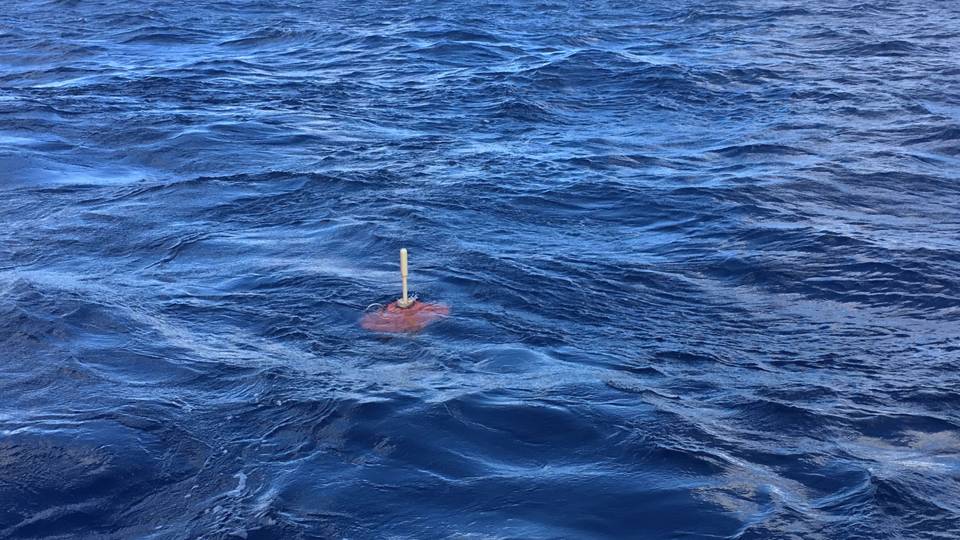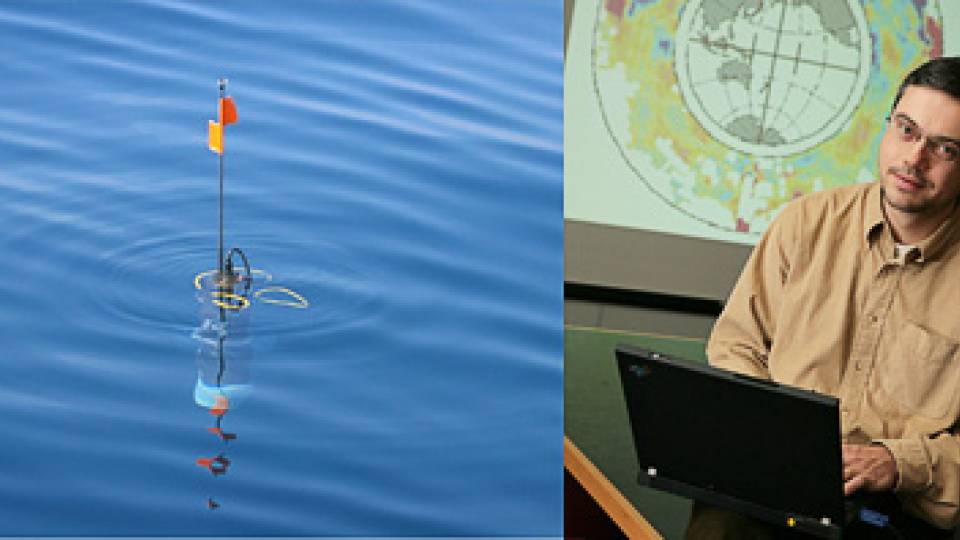On a ship off the coast of Bermuda, Frederik Simons, an associate professor of geosciences at Princeton University, fastens a rope around a six-foot-tall white cylinder affixed with solar panels and various wires suspended in a metal frame. As everyone scrambles into position, a crane slowly raises the device and prepares to lower it into the ocean. After three years of work on design modifications and fine-tuning, the researchers are preparing to test the apparatus for the first time.
The instrument, named Son-O-Mermaid, will detect and record waves, but not the kind that are rolling under the research vessel and making Simons seasick. Son-O-Mermaid measures sound waves created by the quaking of the earth far beneath the ocean surface. Just as a CAT scan can enable physicians to "see" inside the human body, geologists can use earthquake data to survey the interior structure of the planet. With two-thirds of the Earth covered by water, Son-O-Mermaid is one of only a few instruments able to record earthquakes in the ocean.
The origins of Son-O-Mermaid began more than two decades ago with an idea from collaborator Guust Nolet, who was then a professor at Princeton and is now the George J. Magee Professor of Geoscience and Geological Engineering, Emeritus. He is also professor of geophysics, emeritus, at the University of Nice-Sophia Antipolis in France.
While on sabbatical at the Scripps Institution of Oceanography in San Diego, California, Nolet met a colleague who was measuring sound waves in the ocean. Among the whale songs and passing freighters, Nolet detected the signal of an earthquake that came all the way from Alaska. He realized that it might be possible to use sound waves — which are the audible equivalent of seismic waves that travel through the Earth — to build a better picture of the planet's structure in regions inaccessible underneath the oceans.
This is important because geoscientists can use seismic waves, the elastic vibrations emitted by earthquakes, to map the structure of Earth's interior. These waves travel faster when passing through colder, denser regions deep inside the Earth, such as subduction zones where tectonic plates collide and one slides under the other, and slower in hotter regions such as mantle plumes, which are upwellings of hot rock. By careful analysis of how the waves travel and change, geophysicists can create 3-D maps of the inside of Earth's crust and mantle. On smaller scales, similar principles are used to prospect for oil, gas and other mineral deposits.
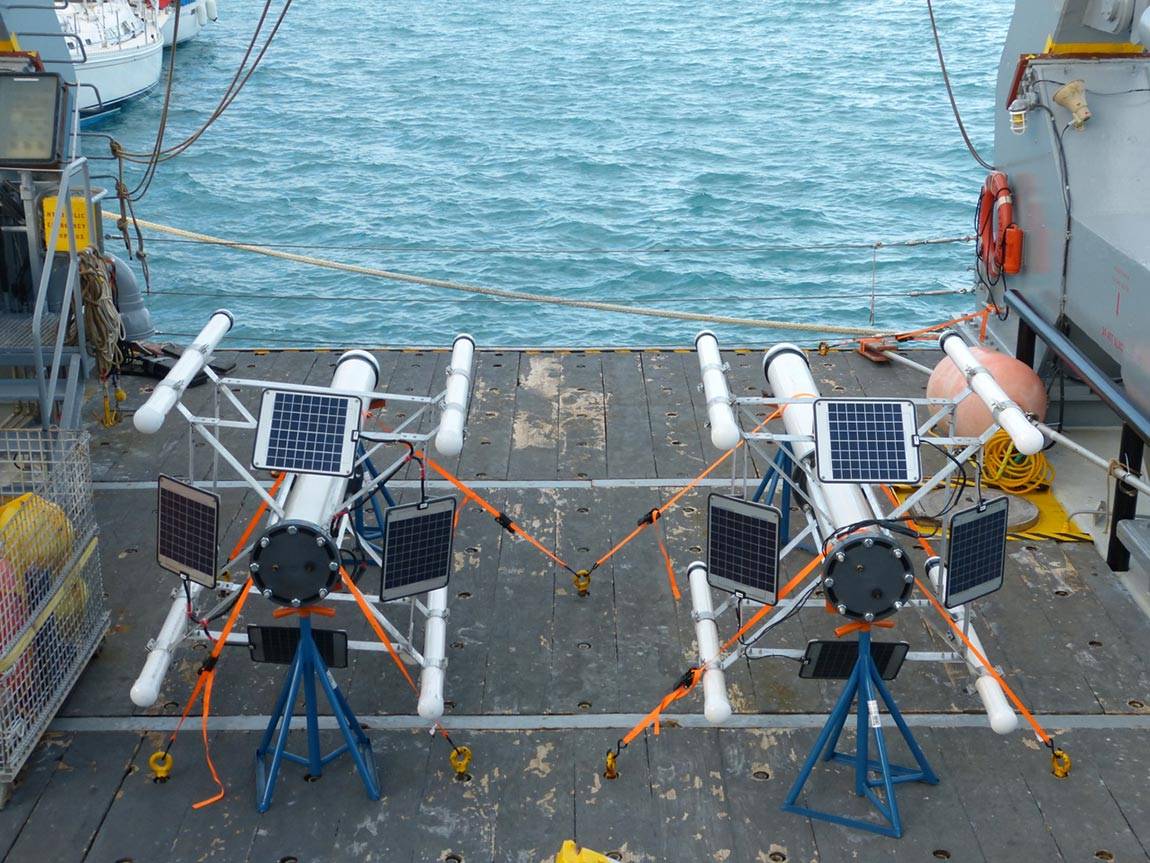
Simons and his team took two Son-O-Mermaid instruments to Bermuda last summer, where Princeton has a partnership with the Bermuda Institute for Ocean Sciences. Here, the instruments are secured on deck before deployment in the water. Unlike traditional ocean-bottom seismometers, which are placed in stationary locations and must be retrieved to obtain their data, Son-O-Mermaid drifts with ocean currents and regularly reports data back to scientists using wireless technology. Several can be deployed for the same cost as one ocean-bottom seismometer. (Photos by Frederik Simons, Department of Geosciences)
Although many seismic stations dot the continents, few have been installed in the oceans. "If you think of the Earth as a patient in the hospital, the present situation is like trying to do a CAT scan with two-thirds of the sensors broken," explained Nolet.
Nolet realized that hydrophones, which are microphones that record sound in water, could be deployed on mobile devices floating in the oceans. But at the time, the technology did not exist to make the project workable, and Nolet put the idea aside.
Ten years later, Nolet brought the project to Simons, who was then a postdoctoral researcher in the Department of Geosciences at Princeton. "Guust sent me a brown envelope marked 'confidential,'" Simons recalled. "Inside was a picture of a seismogram — the record of a seismic wave — and a proposal to build a dedicated instrument that could record earthquakes in the ocean." Simons and Nolet envisioned deploying tens or hundreds of these instruments throughout the world's oceans. They built the first version of the device with colleagues at Scripps in 2008 and named it MERMAID, for Mobile Earthquake Recording in Marine Areas by Independent Divers.
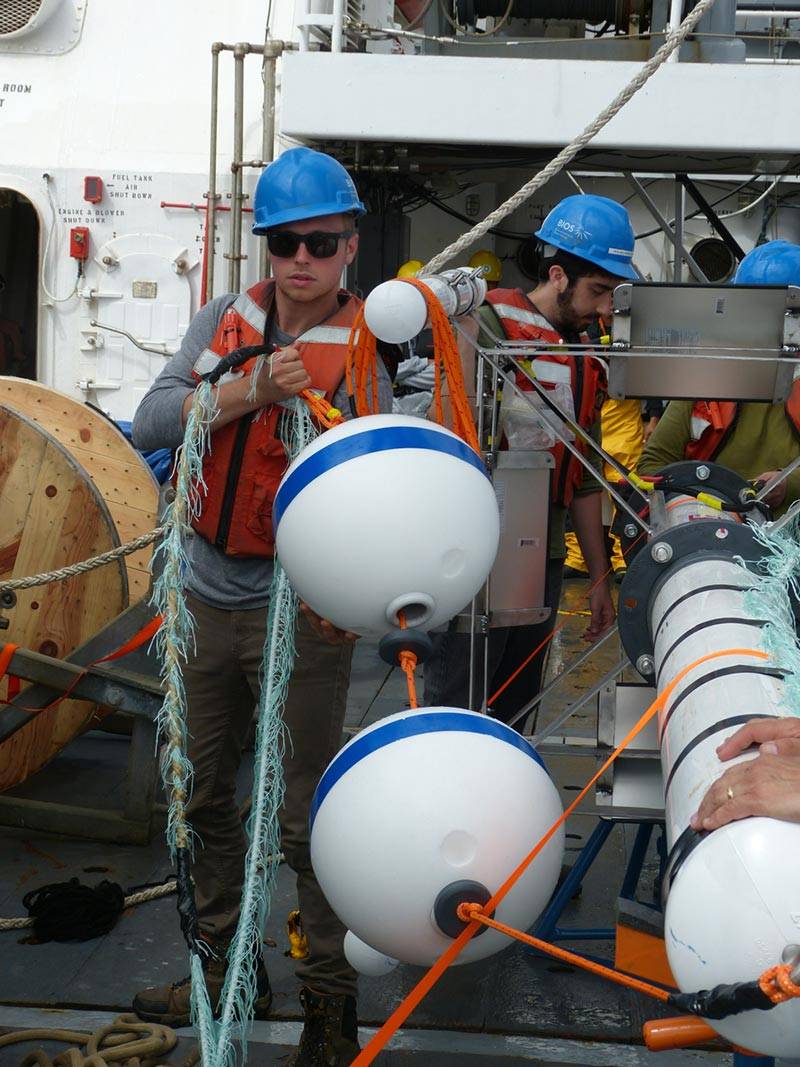
Joel Simon, a Princeton graduate student in geosciences whose research focuses on analysis of the Son-O-Mermaid data, adjusts cables and prepares the instrument for a test run. Simon went to Bermuda a week ahead of deployment with the engineers to unpack the pieces of the instrument from the shipping container and assemble them.
Here is how it works: Once in the water, MERMAID sinks to about a mile deep, drifts along deep ocean currents, and "listens" to acoustic signals. "When there is a ship passing or a whale singing it will analyze the signal and decide whether the sound is due to an earthquake or not," Nolet explained. When it decides that it is an earthquake, MERMAID comes to the surface, takes a GPS measurement of its location, and sends a seismogram by email.
Before MERMAID, undersea earthquake data could be obtained only by traditional ocean-bottom seismometers, which are placed in stationary locations and must be retrieved to obtain their data. "And sometimes when one gets those instruments back," Simons explained, "something might have gone wrong and months of waiting would have been in vain." The high cost of manufacturing and ship time required for ocean-bottom instruments also greatly restrict their use.
MERMAIDs, in contrast, regularly report data back to scientists using wireless technology, and several can be deployed for the same cost as one ocean-bottom seismometer. Last August, Nolet, Simons and colleagues published a paper in the journal Nature Communications reporting that the divers successfully recognized earthquakes and transmitted the seismograms more or less in real time.

A Son-O-Mermaid instrument is attached to a crane and lowered into the ocean. The researchers will next reel out 1,000 meters (more than 3,200 feet) of cable that connect the surface buoy to hydrophones, microphones that record sound in water, which "listen" for earthquakes in the ocean. When an earthquake is detected, the device sends a seismograph by email to the scientists.
Meanwhile, Simons had already started to design adjustments and new features to overcome some of MERMAID's limitations. He developed Son-O-Mermaid with colleague Harold "Bud" Vincent, a research professor at the University of Rhode Island. Both MERMAID and Son-O-Mermaid possess a series of hydrophones, but Son-O-Mermaid's hydrophones are suspended from a long cable that connects to a drifting buoy that stays at the surface.
This new design has some advantages. MERMAID uses an electrically powered buoyancy pump to bring itself to the surface each time it reports an earthquake, so it functions only as long as the battery lasts. Son-O-Mermaid is equipped with solar panels to supply it with power. In addition, Son-O-Mermaid can maintain continual contact with a satellite, instead of only connecting when it surfaces. It always knows where it is and exactly what time it is. Comparing the exact arrival time of a seismic wave with predictions based on how waves travel through different materials is a crucial step in using seismogram data to create models of the interior of the Earth.
Despite these advantages, Son-O-Mermaid does have drawbacks. The buoy is at the surface, in the waves, so it can get run over by ships — or be hit by a hurricane, as the very first Son-O-Mermaid prototype was during its maiden voyage three years ago.
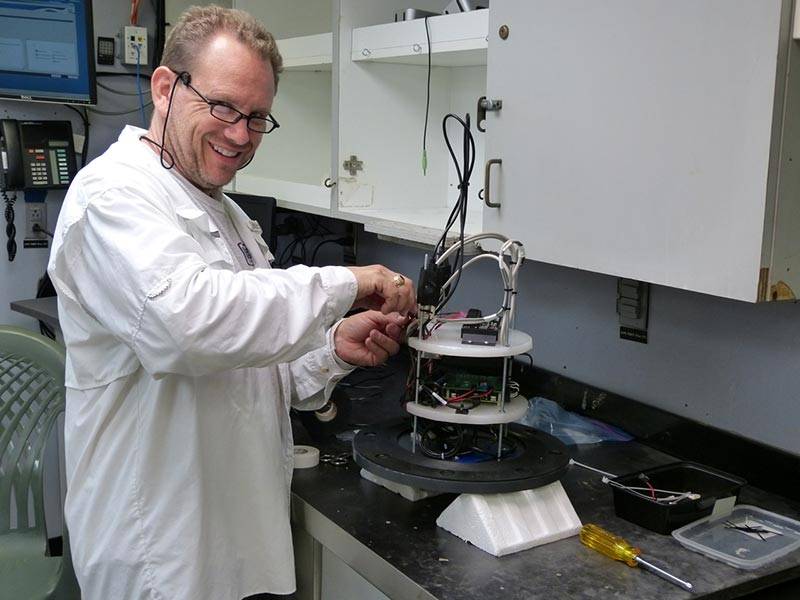
Harold "Bud" Vincent, a research professor at the University of Rhode Island and main collaborator in designing and building Son-O-Mermaid, prepares part of the instrument before deployment. After the first prototype was hit by Hurricane Sandy off the coast of the Bahamas in 2012, Simons and Vincent have worked to fine-tune Son-O-Mermaid over the last three years, adjusting part of the design to make it more robust.
"Off the coast of the Bahamas," Simons recalled, "we successfully deployed it. It was reporting its position faithfully every hour for a number of days until it went silent, which was when it ran right through the eye of Hurricane Sandy."
Over the next few days they heard nothing and feared it was lost. Eleven days later it came back online and started communicating again. "It reported that it was indeed alive and had survived the hurricane, but alas, its reporting package hadn't, so we lost the data from that very first trip," Simons said.
Over the next three years, Simons and Vincent worked to fine-tune Son-O-Mermaid, adjusting part of the design to make it more robust to withstand events like Sandy.
The latest Son-O-Mermaid deployment took place last summer. Simons and Vincent took two Son-O-Mermaid instruments to Bermuda, where Princeton has a partnership with the Bermuda Institute for Ocean Sciences. The team included graduate students, technicians and undergraduates who were on deck helping to move the instrument. They hooked it to the pulley and crane system, lowered it into the ocean, and reeled out the 1,000 meters of cable that connect the surface buoy to the hydrophones.
Joel Simon, a Princeton graduate student in geosciences whose research focuses on analysis of the Son-O-Mermaid and MERMAID data, went to Bermuda a week ahead of deployment with the engineers to unpack the pieces of the instrument from the shipping container and assemble them. "My current research focuses on answering the question, 'Given a signal, can you automatically (1) tell if the signal is from an earthquake or other source, and (2) precisely tell the arrival time of the signal at the detector,'" he said.
He continued: "Probably the most excited I've been during this research was when I saw the first core phase returned in the data — an earthquake on the complete opposite side of the Earth generated a seismic wave that passed through the inner core [of the Earth] and then was detected as a sound wave at a MERMAID float. Seeing that for the first time blew my mind. Now, logging into my computer every morning and downloading new seismograms is exciting because I never know what interesting waveforms I will get."
The research team deployed and retrieved the buoys several times to test that everything was working and identify remaining kinks that are now being addressed. "As a proof of concept, Son-O-Mermaid proved its seaworthiness," Simons said. "Now the task ahead is to construct a robust new generation of Son-O-Mermaid instruments to add to the growing number of earthquake recorders, including MERMAID, in the oceans." With each new instrument deployed, Simons and colleagues will help fill in the picture of our planet's interior.
Partial funding for Simons' work was provided by the National Science Foundation and by the A.H. Phillips Fund in the Department of Geosciences at Princeton.

A Son-O-Mermaid instrument in the water. The research team deployed and retrieved the buoys several times to test that everything was working and to identify remaining kinks. Now the task ahead is to construct a robust new generation of Son-O-Mermaid instruments to add to the growing number of earthquake recorders in the oceans. With each new instrument deployed, Simons and colleagues will help fill in the picture of our planet's interior.

